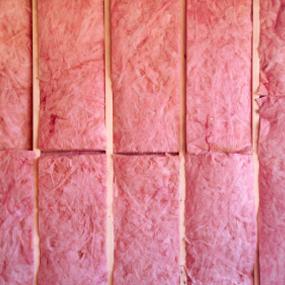Build it Back Greenbushfires
Insulation
 One of the best ways to
save money on energy bills is to insulate your home. Insulation is
like a barrier, preventing heat passing in and out of the
house.
One of the best ways to
save money on energy bills is to insulate your home. Insulation is
like a barrier, preventing heat passing in and out of the
house.
By reducing heat flow you can maintain a comfortable temperature inside, regardless of the temperature outside.
In winter, once the dwelling has been heated to a comfortable level, it will stay that way with less energy input than an uninsulated home.
In summer the insulated home will take longer to heat up, and air conditioners will need less energy for cooling.
There are two main types of insulation: bulk and reflective. Bulk insulation comes in many shapes, thicknesses and materials and is primarily used in ceilings and sometimes in walls.
The most common bulk insulation material is mineral wool or glass fibre. Other materials include recycled and virgin polyester, wool and cellulose fibre. Bulk insulation stops heat flow by trapping air in small air pockets.
Reflective insulation resists radiant heat by reflecting or not emitting heat. It is usually shiny aluminium foil laminated onto paper or plastic. Reflective insulation needs a layer of air between its shiny reflective side and the roof or wall cladding. The insulation's effectiveness can also decrease if it becomes dirty or dusty.
When looking for insulation you will come across the term 'R-value'. The R-value measures the product's ability to insulate, or resist heat transfer. The higher the R-value, the greater the level of insulation. A batt with an installed R-value of R1.5 will let more heat through than an R2.6 batt.
Another insulation term you may hear is U-value, which is the opposite of R-value. The U-value relates to how well the material transfers heat. With U-values, the lower the number the better. Bulk insulation products come with one R-value for a given thickness. Reflective insulation's R-value depends on where and how the insulation is installed.
The type and level of insulation you need for your home varies on where you live, the building materials used for your house and whether you will be using additional heating or cooling. A home in an alpine region would want to stop heat flowing out in winter and prevent heat coming in during summer. These homes benefit from reflective insulation under the roof, floors and in walls, and bulk insulation in the ceiling.
Most common building materials have little insulating value, but there are some other options available. Aerated concrete blocks, fibre reinforced gypsum, hollow expanded polystyrene blocks, rendered strawbales and rendered polystyrene sheets can insulate your home with little or no need for additional insulation.
When installing insulation make sure there are no gaps as this decreases the effectiveness of insulation. This is especially a problem with halogen downlights in ceilings.
Finally, when choosing insulation compare the environmental benefits of different products. Ask how much of the product is made from recycled materials and how easily the product can be recycled. For example some products are made from 80 per cent recycled plastic drink bottles or 100 per cent recycled paper.
The higher the bushfire risk, the greater the caution required in selecting appropriate insulation products. Some insulation products are non-combustible and non-flamable (e.g. Rockwool) and so are recommended to seal roof/wall junctions for example.
Other products such as reflective foil roof sarking are required to stop embers under tiles and metal sheet roofs. Depending on your Bushfire Attack level (BAL), some insulation products (e.g. polystyrene, polyurethane blocks and panels, PVC) may not be suitable because they could be exposed to heat or flame in external walls.
Suppliers
Air-Cell Insulation - www1.air-cell.com.au
Ph. 1300 247 235
Autex - www.autex.com.au
Ph. 03 9457 6700
CSR Bradford Insulation - www.bradfordinsulation.com.au
Ph. 1300 850 305
Cool or Cosy Natural Insulation - www.coolorcosy.com.au
Ph. 13 33 34
Enviroflex - www.enviroflex.com.au
Ph. 03 9753 3811
Fletcher Insulation - www.insulation.com.au
Ph. 1300 654 444
Green Insulation - www.greeninsulation.com.au
Ph. 1300 308 164
Higgins Insulation - www.higginsinsulation.com.au
Ph. 1300 130 233
Insulation Superstore - www.insulationsuperstore.com.au
Ph. 1300 360 346
Wren Industries - www.concertinafoilbatts.com
Ph. 03 9532 5855
- More Info
- > ResourceSmart
- > ReNew magazine insulation buyers guide
- > Your Home
Listed suppliers are a guide and are not endorsed by Green Cross Australia or the Alternative Technology Association.
Latest images
flickrLatest videos

Anthony Smith, resident of Kinglake, talks about building his new Nine Star Home in the aftermath of Black Saturday.

Les' home is an inspiring example of smart green building, and his plans for living green will maximise energy savings and comfort. But it wasn't easy.


